How Ohio Cities Showed Kamala Harris the Way Forward on Medical Debt
The vice president wants a medical debt jubilee. Toledo, Cleveland, Columbus, Cincinnati, and Akron demonstrated what that could look like.
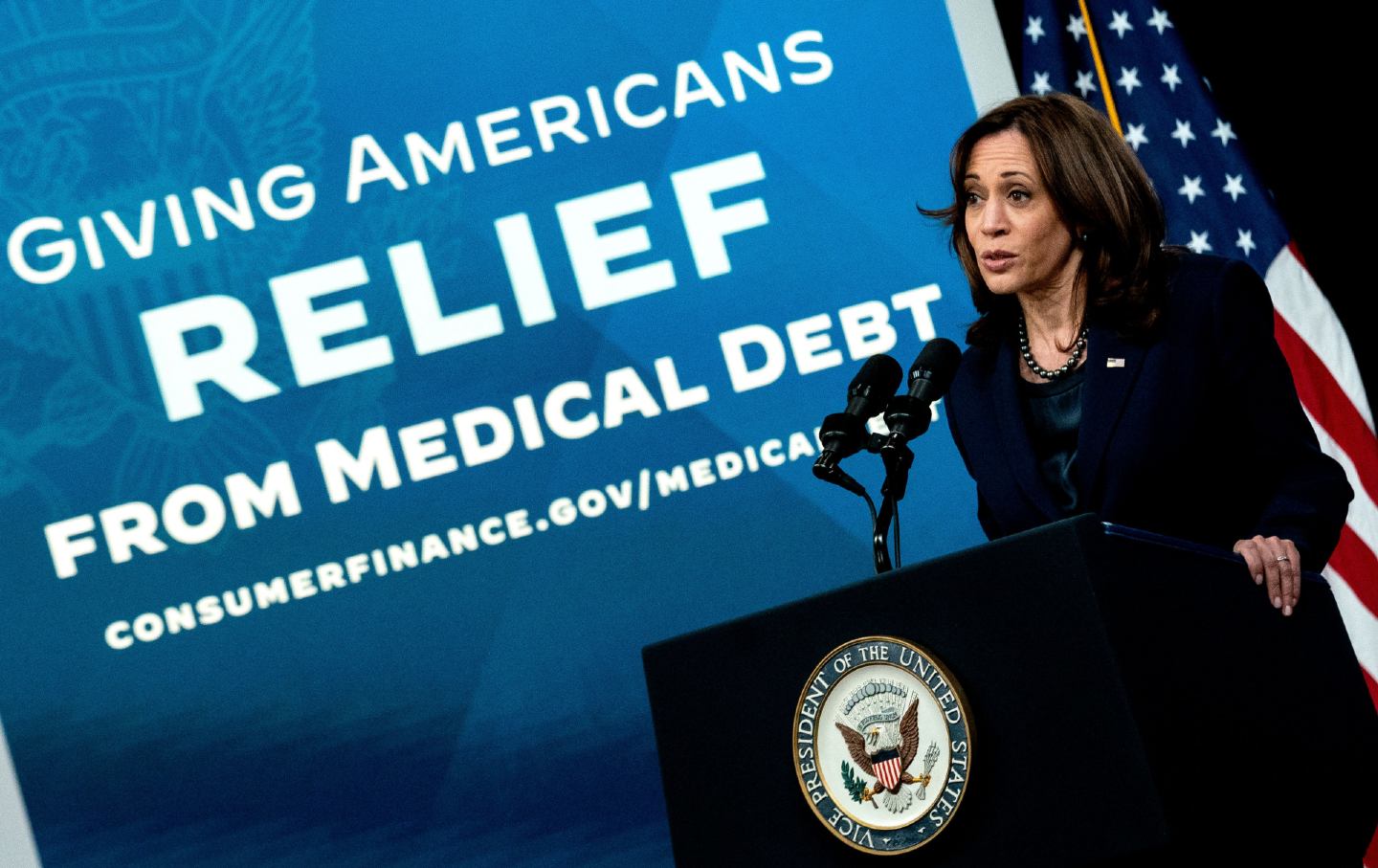
Vice President Kamala Harris delivers remarks on medical debt relief at an event at the Eisenhower Executive Office Building, next to the White House, in Washington, DC, April 11, 2022.
(Stefani Reynolds / AFP via Getty Images)Cleveland—Medical debt is a national crisis, and Kamala Harris has a plan to deal with it; she just needs to tell people about it. And to do that, she should first talk about Ohio.
About 41 percent of working-age Americans carry medical debt, according to surveys by the Commonwealth Fund and the Kaiser Family Foundation. The figures vary depending on how medical debt is defined—whether a hospital is owed the money or the debt is on a credit card or owed to another lender—but somewhere between 79 to 100 million Americans owe a total of more than $220 billion. Most people with debt have health insurance, and medical debt is one of theleading causes of bankruptcy. Daniel Lempert, the vice president of communications for the nonprofit Undue Medical Debt, pointed out that half of adults in the US don’t even have $500 for an emergency expense. “With all that in mind,” he told me, “it’s unsurprising that almost anyone is one accident or illness away from financial crisis.”
In August, Kamala Harris announced a plan for federal medical debt forgiveness, saying, “No one should go bankrupt just because they had the misfortune of becoming sick or hurt.”
The Harris plan was light on details about how precisely the debt jubilee would be enacted, but Ohio provides a road map on how a Harris administration could work with local governments, hospital systems, and nonprofits to wipe out medical debt for millions of Americans. Ohio is ranked 44th among the 50 states for “health value,” according to the Health Policy Institute of Ohio, meaning residents “live less healthy lives and spend more on health care than people in most other states.”
Nearly 2 million Ohioans have medical debt, and as the Covid-19 pandemic shut down the economy, local politicians were worried about this debt pushing people deeper in poverty. “This isn’t vanity debt,” Kris Harsh of the Cleveland City Council told me. “For people with insurance, their plans are not covering the entirety of the costs, and for those without insurance, the debt is usually the result of an emergency.”
In late 2022, the city of Toledo set aside a portion of America Rescue Plan Act (ARPA) funds to forgive medical debt. It used the money to buy up the debt portfolios of two local hospital systems that they had sold to third-party collectors. Once the portfolios were purchased, they were marked as paid. It was Michele Grim, then a city councillor and now a Democratic state representative, who led the initiative
Toledo did not do this on its own, though. It followed Cook County, the area surrounding Chicago, and partnered with the nonprofit Undue Medical Debt. The group began its work in 2014, and Lempert told me that, at first, “the idea that debts are bought and sold for pennies on the dollar, especially medical debt, was foreign and frankly confusing for many people.” He said a 2019 segment on John Oliver’s Last Week Tonight helped; it explained the process, and the show even bought and forgave $15 million of medical debt for 9,000 Texans.
Hospital systems will sell the debt knowing that patients will unlikely be able to cover the costs left over after insurance companies cover their portions of accrued bills. Third-party collections agencies will buy the debt for cheap, but once it has been sitting with them for some time, they often give up attempting on collecting on it, too. That’s when Undue Medical Debt is able to buy the debt portfolios for pennies on the dollar. It gives the third-party collectors some compensation for the portfolio and allows patients much-needed relief. The bills will be marked as paid.
How much these portfolios cost vary by hospital system, number of patients, and the amount of time the debt has been in collection, Lempert said.
When Harsh learned about this, he jumped on the chance to help Clevelanders, too.
The ARPA funds were meant to provide relief in the wake of the pandemic, but the money wasn’t specifically intended for medical debt forgiveness. As Lempert put it, Ohio cities found ”a creative use for these funds.” Columbus, Cincinnati, and Akron would eventually join Toledo and Cleveland in using federal funds to forgive medical debt.
Popular
“swipe left below to view more authors”Swipe →According to the Urban Institute, medical debt both in Ohio and across the country is more common in communities of color. In Cuyahoga County, which includes Cleveland, majority non-white communities have twice the rate of medical debt of white communities. And across the country, more than 20 percent of residents in communities of color have medical debt in collections.
In Cleveland, Harsh and the rest of the city council worked with the Metro Health hospital system, one of the largest in the city, to forgive $200 million in debt for nearly 300,000 patients.
There are some caveats with these kinds of deals. Undue Medical debt can’t select specific people, but it can, Lempert said, “target zip codes for debt forgiveness and basically ensure that we were helping Cleveland residents first and foremost. Of course, some debt was held by people who’ve moved away since the debt was initially incurred. and there was some natural overlap into our surrounding suburbs.”
The group also focuses on patients who are four times or below the federal poverty level and those whose debt is 5 percent or more of their annual income, as Lempert explained. He said the nonprofit’s process is appealing to officials because of the “ROI [return on investment] of medical debt abolishment and the ability to help burdened citizens without any red tape or application process.”
Lempert said that “the main challenge has just been shedding light on this crisis which can be highly stigmatizing and therefore underexplored.” But by sharing personal stories and with more and more municipalities and cities reaching out, there has been increased visibility and more people helped. Undue Medical Debt has forgiven more than $14 billion in debt across the country.
Jenny, whose name has been changed at her request to protect her anonymity, was a patient of Metro Health and said she has had “approximately 14 surgeries since 2015.” She said had employer healthcare until 2015 but was not eligible for Medicare until 2019. In the intervening years, her medical debt piled up. The pandemic and a 2020 breast cancer diagnosis made it impossible for her to work and pay off that debt.
She said that when she was 62, she couldn’t find a job and was forced to take smaller Social Security payments. With her ongoing tests and having to move to be closer to family members, she could barely keep up with the calls and letters coming from the collection agency. Thankfully, Undue Medical Debt bought her debt from the third-party collection agency, and as of early 2024, her bills were considered paid.
Now 71, she still sometimes struggles to make ends meet on her fixed income, but she doesn’t feel forced to go back to work. She told me, “I’d like to see more people get the same kind of help to put their minds at ease. When you have a critical condition, you got enough on your mind without having to worry about getting help.”
Samuel Camacho, a disease and intervention specialist, was a patient of Trinity Health System when he was a freelancer and covered by a marketplace insurance plan in Ohio. Camacho said his primary care physician, urgent care, and emergency room as well as his prescriptions “were all in network.” After a diagnosis of kidney stones, he was asked by the hospital to sign a financial document “on admission to the procedure without explaining what [that document] was.”
Camacho later found out he had not met his deductible and so the full bill was his responsibility. He tried to get on a payment plan with Trinity only to be told the hospital no longer provided payment plans; it had sold his debt to a third party. He has said he was “not familiar” with debt relief through deals brokered with Undue Medical Debt but is currently working with an attorney to resolve his issue, since his hospital system was not included in any of the Ohio city-brokered deals.
Harris has been campaigning on her economic plan all over swing states, but she’s been relatively quiet about medical debt forgiveness, which is an extension of the work she did with the Biden administration. Neither Camacho nor Jenny had not heard Harris talk about medical debt forgiveness. “It wouldn’t hurt” to talk about it, Jenny said. “I’m sure I’m not the only one in this situation.”
About 15 million Americans have medical debt on their credit reports, per the Consumer Federal Protection Bureau. That number is down from 46 million in 2020, thanks in part to Harris-led initiatives urging credit bureaus to remove this type of debt from credit reports. Harris has also called on that debt to be eliminated from calculating credit scoress and from evaluations for mortgage. Still, few know about Harris’s plans to forgive the medical debt of millions or her history of making medical debt less of a burden.
One of the lawmakers leading the charge in Congress to remove medical debt from credit reports has been Senator Sherrod Brown of Ohio. Brown, whose campaign could not be reached for comment, has a narrow lead in the polls over Republican challenger Bernie Moreno in his reelection bid this year. But he does not appear to be touting medical debt forgiveness on the campaign trail around the state.
Medical debt forgiveness, especially for those with terminal illnesses, is a popular issue with voters—nearly two-thirds of Americans support it. The American Cancer Society Cancer Action Network, the Leukemia and Lymphoma Society, and Undue Medical Debt also did a survey and it showed that 84 percent of US adults agree that it is “the responsibility of the government to ensure health care is affordable for all people in the U.S.” and 91 percent agree that “elected officials should pass policies that protect people with serious illnesses like cancer from medical debt and harassment from collection agencies.”
There is an opportunity here for Harris, Brown, and other Democrats. Ohio is controlled at the state level by Republicans, but local Democratic politicians in cities have proved how popular and cost-effective it can be to forgive medical debt. Federal funds helped Ohio residents be free of over $600 million of debt. It’s an accomplishment that Democrats should be boasting about, and Harris has a plan to bring it across the country. She should campaign on it.
Disobey authoritarians, support The Nation
Over the past year you’ve read Nation writers like Elie Mystal, Kaveh Akbar, John Nichols, Joan Walsh, Bryce Covert, Dave Zirin, Jeet Heer, Michael T. Klare, Katha Pollitt, Amy Littlefield, Gregg Gonsalves, and Sasha Abramsky take on the Trump family’s corruption, set the record straight about Robert F. Kennedy Jr.’s catastrophic Make America Healthy Again movement, survey the fallout and human cost of the DOGE wrecking ball, anticipate the Supreme Court’s dangerous antidemocratic rulings, and amplify successful tactics of resistance on the streets and in Congress.
We publish these stories because when members of our communities are being abducted, household debt is climbing, and AI data centers are causing water and electricity shortages, we have a duty as journalists to do all we can to inform the public.
In 2026, our aim is to do more than ever before—but we need your support to make that happen.
Through December 31, a generous donor will match all donations up to $75,000. That means that your contribution will be doubled, dollar for dollar. If we hit the full match, we’ll be starting 2026 with $150,000 to invest in the stories that impact real people’s lives—the kinds of stories that billionaire-owned, corporate-backed outlets aren’t covering.
With your support, our team will publish major stories that the president and his allies won’t want you to read. We’ll cover the emerging military-tech industrial complex and matters of war, peace, and surveillance, as well as the affordability crisis, hunger, housing, healthcare, the environment, attacks on reproductive rights, and much more. At the same time, we’ll imagine alternatives to Trumpian rule and uplift efforts to create a better world, here and now.
While your gift has twice the impact, I’m asking you to support The Nation with a donation today. You’ll empower the journalists, editors, and fact-checkers best equipped to hold this authoritarian administration to account.
I hope you won’t miss this moment—donate to The Nation today.
Onward,
Katrina vanden Heuvel
Editor and publisher, The Nation
More from The Nation
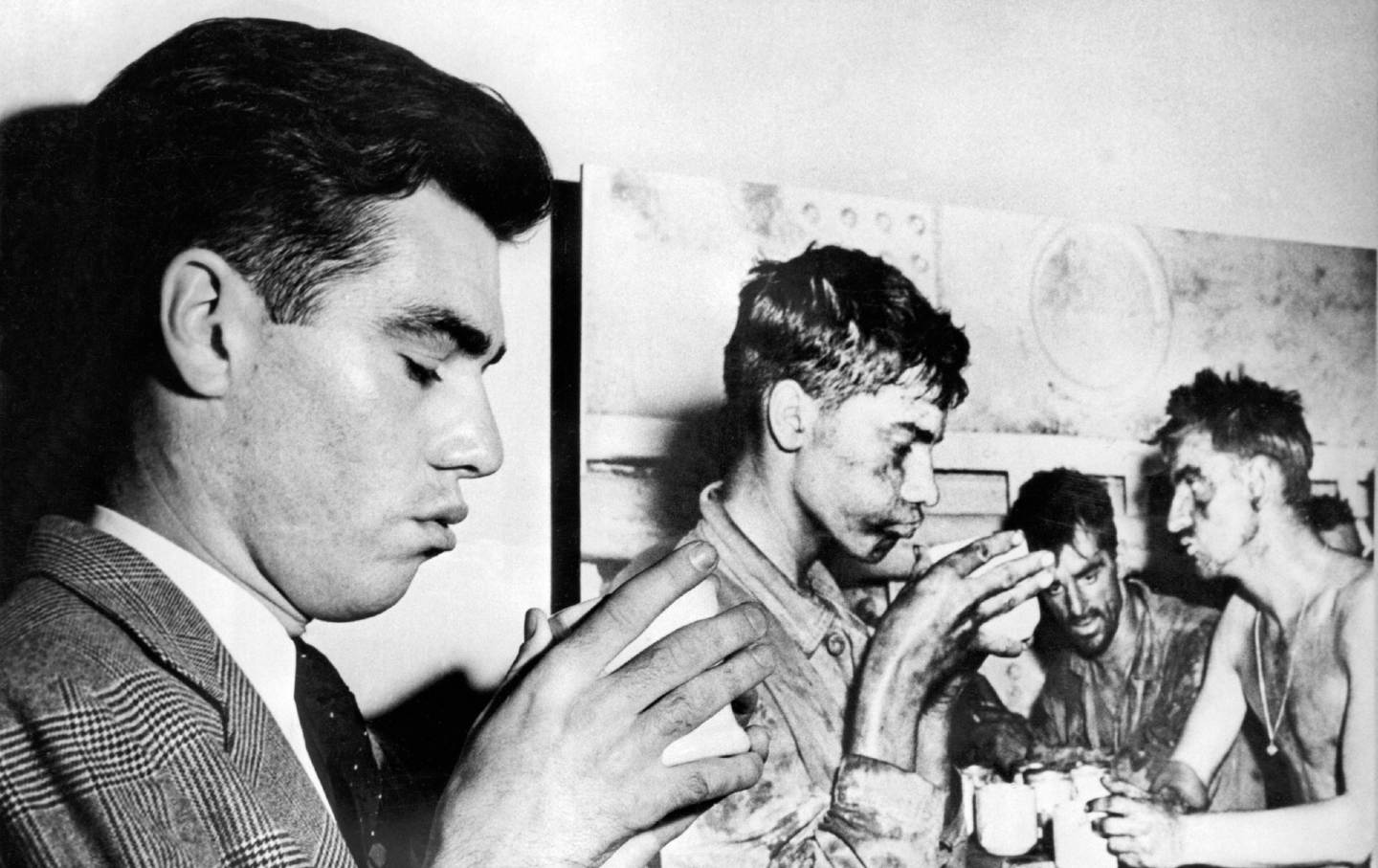
David Nasaw’s Unsparing Tour of America’s World War II and Its Aftermath David Nasaw’s Unsparing Tour of America’s World War II and Its Aftermath
A gimlet-eyed and honest accounting of the war’s hidden costs that still affect us today.
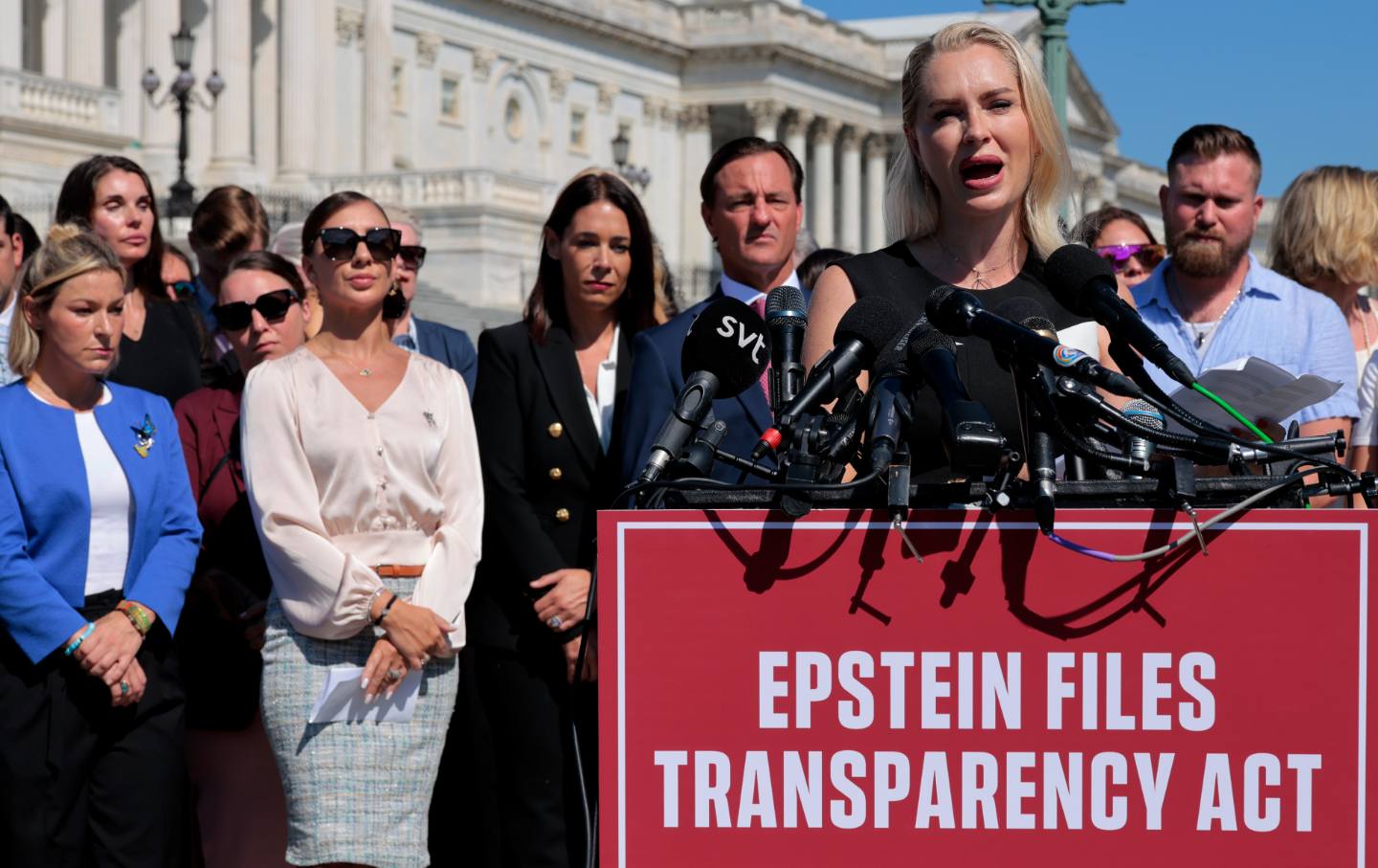
The Epstein Survivors Are Demanding Accountability Now The Epstein Survivors Are Demanding Accountability Now
The passage of the Epstein Files Transparency Act is a big step—but its champions are keeping the pressure on.
Letters From the January 2016 Issue Letters From the January 2016 Issue
Malice aforethought… Sheep throat… Standing room only… Correction…
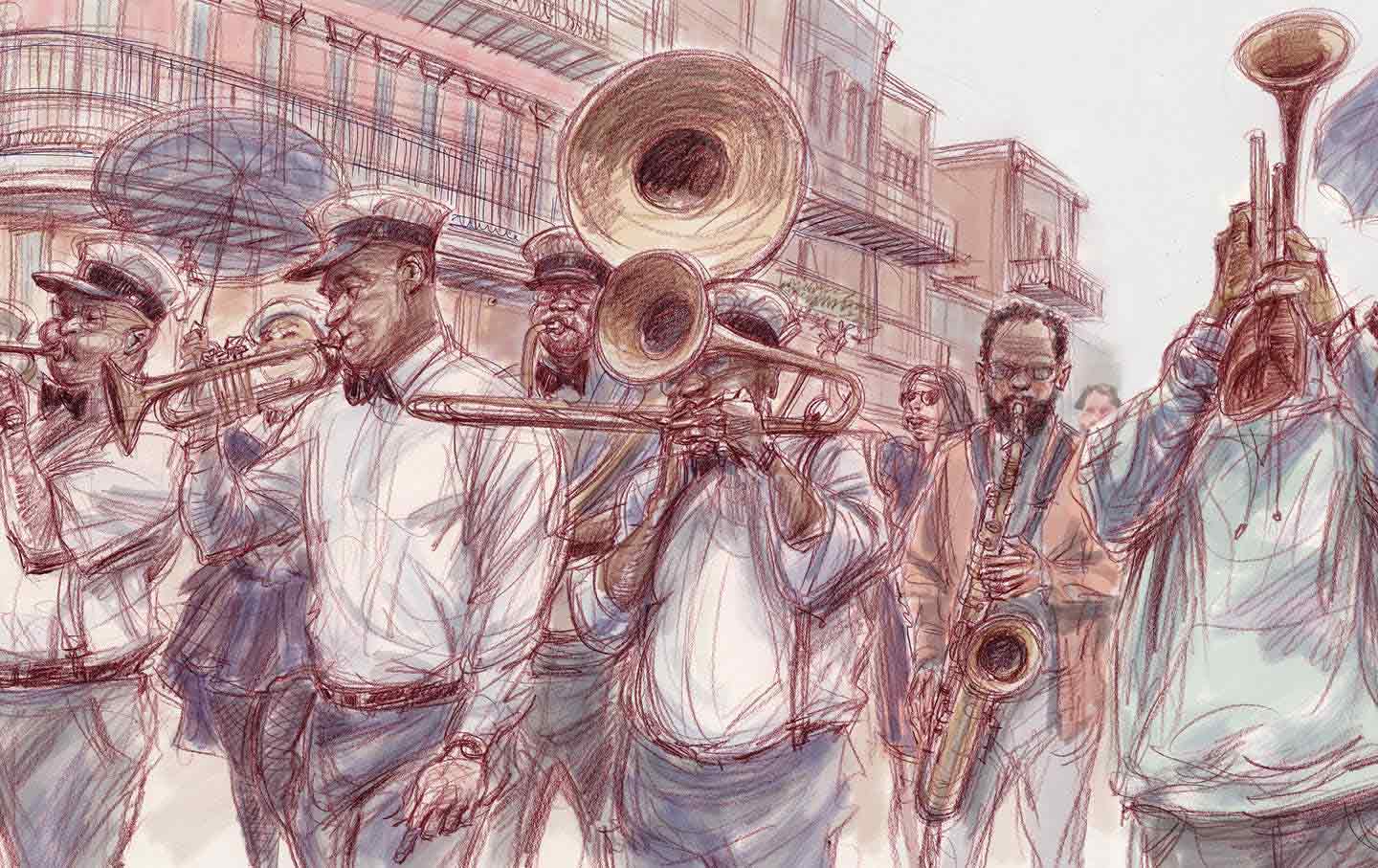
The Fight to Keep New Orleans From Becoming “Everywhere Else” The Fight to Keep New Orleans From Becoming “Everywhere Else”
Twenty years after Katrina, the cultural workers who kept New Orleans alive are demanding not to be pushed aside.

Breaking the LAPD’s Choke Hold Breaking the LAPD’s Choke Hold
How the late-20th-century battles over race and policing in Los Angeles foreshadowed the Trump era.
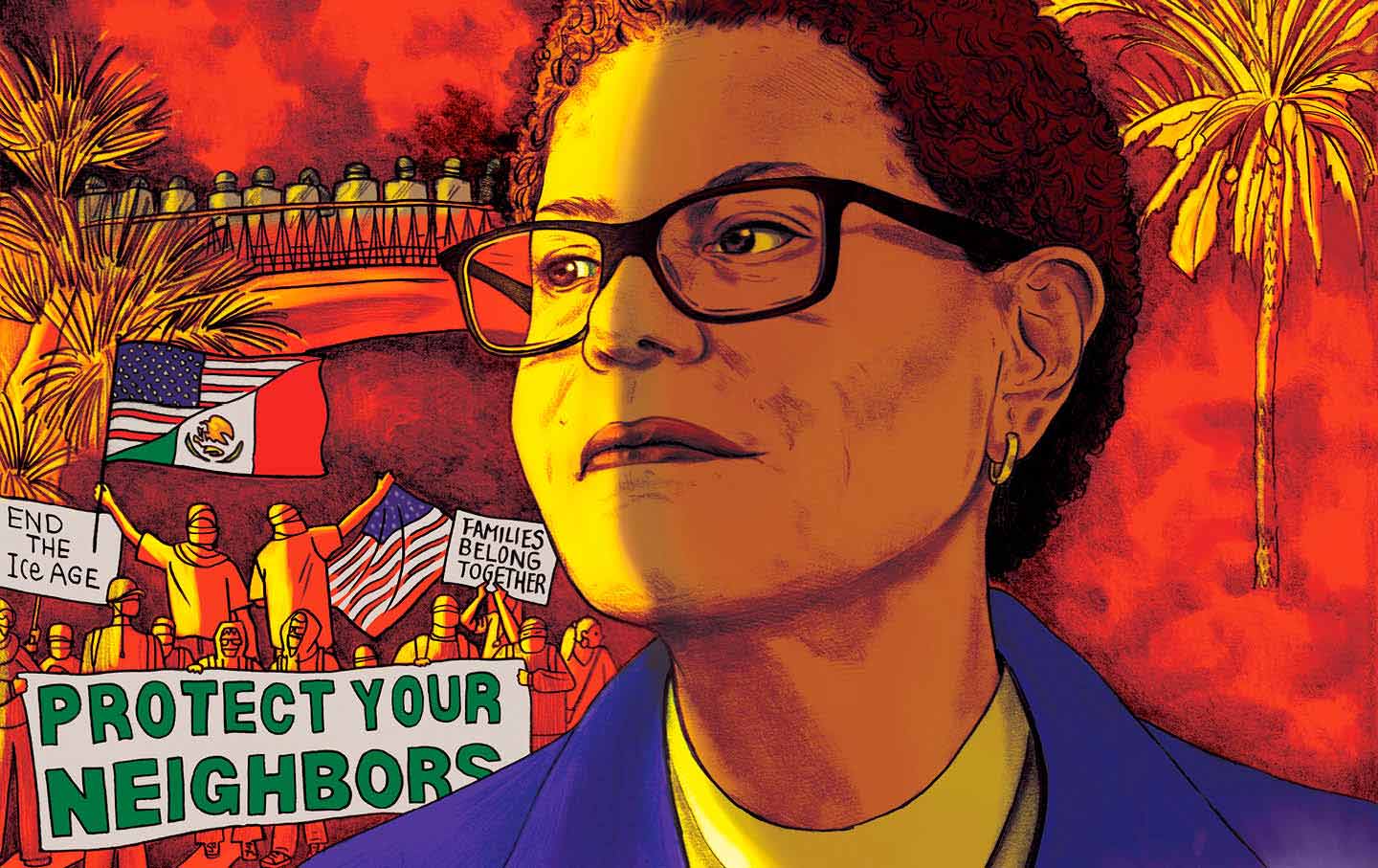
Mayor of LA to America: “Beware!” Mayor of LA to America: “Beware!”
Trump has made Los Angeles a testing ground for military intervention on our streets. Mayor Karen Bass says her city has become an example for how to fight back.


